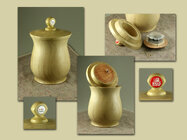Advice I wish I got early on but finally learned:
1. learn to sharpen and do it often
2. find a mentor and learn
3. learn the line of fire and stay out of it.
4. be sure you need a tool before you buy it.
5. Join a local club and attend meetings
6. Read, watch videos, but mostly turn.
7. learn safety rules and follow them—respiratory and face protection.
8. Research and ideally test drive lathes before a purchase.
9. Take classes from experienced turners.
10. Don’t turn when you are tired.
11. Join and support AAW.
Add to the list.
1. learn to sharpen and do it often
2. find a mentor and learn
3. learn the line of fire and stay out of it.
4. be sure you need a tool before you buy it.
5. Join a local club and attend meetings
6. Read, watch videos, but mostly turn.
7. learn safety rules and follow them—respiratory and face protection.
8. Research and ideally test drive lathes before a purchase.
9. Take classes from experienced turners.
10. Don’t turn when you are tired.
11. Join and support AAW.
Add to the list.
Last edited:

